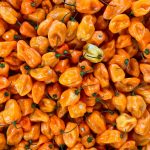Online delicatessen is a place where you buy not only basic, necessary food products, it is also a platform where you can buy unique products, those that are not always available in stationary stores. These are certainly habanero peppers, these extremely spicy, intense peppers, spicy in taste. Not everyone likes them, you have to eat dozens of different peppers beforehand for our palate to accept oh fire.
Habanero peppers for the most resistant
Capsicum chinense is the Latin name for habanero, one of the pepper species whose fruits are among the most spicy and spicy. Like most species of this plant, it comes from the South American continent, from the Amazon region. Its official discoverer was the French chemist and biologist Professor Nikolaus Joseph von Jacquin, who, however, convinced that he was in China along with his expedition, gave it the nickname Chinese and it has remained so until today. The term habanero, referring to its origin in Havana, covers all varieties of this species, although it is extremely rare in Cuba. Today, the largest producer of habanero is Mexico, although it is also grown in Costa Rica, Colombia, Ecuador and Belize.
- https://www.nomen.com.pl/jaki-nadruk-na-bluze/
- https://www.santmat.pl/jak-rozpoznac-dopalacze-od-amfetaminy/
- https://www.bojadla.edu.pl/kompendium-wiedzy-o-kontenerach-morskich-chlodniczych/
How are habanero peppers grown?
Available at the online grocery store, habanero, like the entire species, is relatively easy to grow. Seeds are sown in early spring, in February or early March. Such an early date is forced by a long growing season, because the peppers must grow, bloom and bear fruit during one season. However, we will not make a big mistake when we decide to overwinter the peppers. This is best done at home and at room temperature. It should not fall below 15 degrees Celsius. Habanero likes the sun, so it’s best to place it somewhere on a sunny windowsill. It turns out that the home environment is conducive to a better yield of peppers, which bear the most fruit in the second and even third year. So it is worth taking care of them in such a way, remembering that the power of peppers is so intense,
Habanero peppers also do not have exceptional requirements in relation to the soil in which they grow, they like slightly acidic soil with a pH of 5-6. When caring for the plant, remember to drain it, the pepper does not like excess water, so it should be watered only when the substrate is completely dry, we do not make water refills. It turns out that excess water changes the taste of peppers to bitter.
Habanero likes sun and warmth
Growing habanero peppers at home is extremely simple. All you need is a pot and lots of sun, especially in the morning. Indoor plants will be slightly shorter than those grown outdoors in gardens, but their potency will be similar. Contrary to appearances, the care of a plant growing directly in the ground is more demanding. Flowerbeds need to be weeded and watered, if it is possible to create greenhouse conditions for them. They need to be guarded against the ubiquitous snails and cared for like any other plant in the garden. And, of course, in the fall, transfer to a home pot. Pepper does not require special fertilization, it should manage without support, and if necessary, let it be a natural fertilizer. In winter, the plant does not need to be fertilized in a pot.
The power and nutritional properties of habanero peppers
All lovers of spicy and spicy peppers are well aware of what SHU Scoville Heat Units is, i.e. a specific qualifier of the power of peppers, evaluating it based on the content of capsaicin in the plant. It is a substance that is responsible for the taste and strength of peppers, for example:
-
-
- a common pepper contains 100 SHU
- cayenne contains from 30,000 units to 50,000
- habanero contains between 100,000 and 350,000 units
- pepper X contains 3.18 million units
-
However, it is not only the strength and spiciness of habanero peppers that matters. Nutrition specialists also appreciate it for the high level of vitamin C, vitamin A, B group, E. Peppers also contain minerals: phosphorus, potassium, sodium, iron, calcium, magnesium, zinc, manganese. The edible part of pepper pods contains antioxidants, chemical compounds also called antioxidants or antioxidants that protect our body from oxidative stress by hunting free radicals. Peppers also contain ascorbic acid and carotenoids.
Habanero pepper price
The price of one kilogram of habanero peppers depends on several variables. Fresh, dried and ground peppers are available for sale. Whole peppers are sold with or without petioles. Remember that habanero is a genre that includes many versions with varying degrees of strength. Each version has a separate price depending also on the distributor. One kilogram of fresh habanero starts at PLN 70-90. A kilogram of dried pepper can cost PLN 260-400. One dry pepper costs PLN 4-6. Peppers are available in online delis and online grocery stores.








